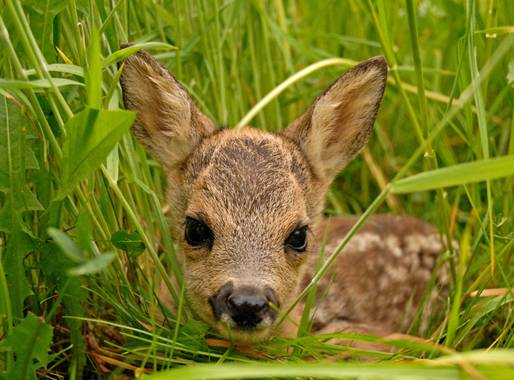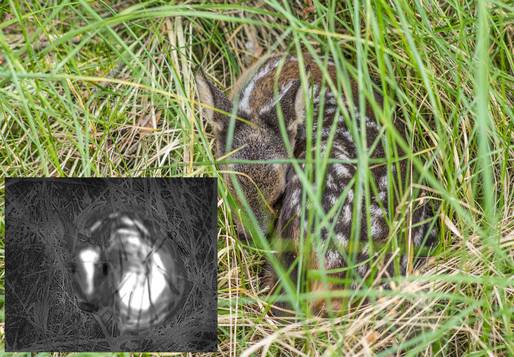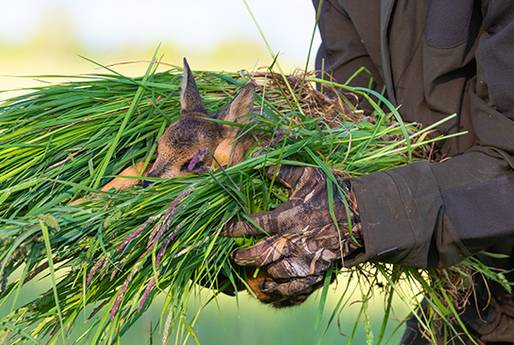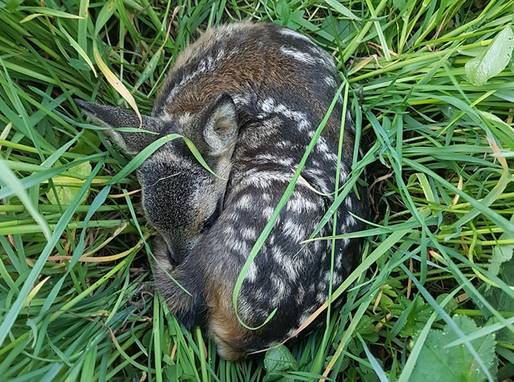Fawn rescue with drone and thermal imaging camera » Simple, fast and efficient
Updated: 20.04.2023 | Reading Time: 4 minutes
This text is machine translated.
From the beginning of May, roe goats place their newborn young in the tall grass for cover, camouflage and protection from other wild animals. Due to their spotted fur and lack of scent, the young are naturally well protected and very difficult for predators to find. In the first three to six weeks, the mother animals (doe) only visit their fawns to suckle. In the time in between, the fawns rely on their natural camouflage and do not show any flight behavior. However, this instinctive behavior inevitably spells doom for the young animals when the meadow in which they are lying is to be mowed. Unfortunately, countless fawns are seriously injured or even killed by the sharp blades of the mowers every year. However, this could easily and effectively be prevented. Using smart drone technology with modern thermal imaging cameras can save many lives.
As already mentioned, fawns are very well camouflaged by nature. Even if you walk through a grassland before mowing, you cannot be sure that you have overlooked a well-camouflaged fawn. In addition, the area that is easily visible when walking is rather limited due to the small distance between the eyes and the ground.
The situation is different when drones fly over the meadow. This is because they can see a much larger area at once due to their flight altitude. In addition, conventional cameras in the visible light spectrum are not used. Instead, special infrared cameras (IR cameras) are used, which react to the animals' heat radiation.
A well-camouflaged fawn, which is almost invisible to the human eye, will shine brightly like a lamp on the image of an infrared camera (thermographic image).
The pilot can view the images from the thermal imaging camera in real time on a display on the remote control. This allows the operator to recognize immediately if there is a fawn in the monitored area.
The right camera for your drone
There are now many drones with cameras on the market. However, only drones that have a built-in infrared camera or thermal imaging camera or can be equipped with a corresponding camera are suitable. The resolution of the infrared camera should be as high as possible in order to be able to clearly image large areas depending on the flight altitude.
Classic video cameras are often used alongside IR cameras to make it easier for pilots to find their way around the transmitter. Inexpensive drones that are only equipped with conventional video cameras, which are intended for producing video clips or images from the air, are unfortunately not suitable for fawn rescue.
GPS function
For larger agricultural areas, it is necessary to fly over the field several times and at precisely defined intervals. This is the only way to carry out a complete scan in flight. However, this requires that the drone has a GPS receiver and can therefore also perform autonomous flight maneuvers. In this case, for example, the UAV editor can be used to program the exact corner points of the meadow area and the planned flight route the day before. The drone will then fly exactly along the planned route regardless of external influences such as wind or thermals. In addition, the GPS function also supports manual flight operation and enables, among other things, an automatic return to the starting point.
Flying time and battery capacity
Another important point is the achievable flight times per battery. The longer the flight time per battery, the fewer spare batteries are required. If there is also a mobile charging option, the batteries can be recharged in the vehicle on the way to the next location.
Our product recommendations
In order for a fawn to be recognized quickly and with the greatest possible certainty, the temperature differences should be well pronounced. This means that the colder the surroundings, the more clearly a warm animal body can be seen. This is why drone flights often take place shortly before sunrise. Depending on the amount of sunlight and temperature development, it can then happen that no meaningful differences in temperature can be measured during the search in the late morning.
If the drone pilot recognizes a fawn in the thermographic image, it hovers over the spot and shows the helpers where it was found. It makes sense for the team to be equipped with radios to transmit information quickly. The farmer can then decide whether to mow the area where the animal was found or whether helpers (gamekeepers or hunters) should pick up the animal and place it in a shady spot at the edge of the meadow. It is important that the young animals are not touched by hand. It is best to use tufts of grass or grain to prevent odor transfer through direct physical contact. Otherwise there is a risk that the fawn will no longer be recognized by the doe or may even be rejected. Ideally, you should monitor from a safe distance whether the doe accepts the young animal calling for her again.
Even if it is primarily about saving fawns, it is not only the wild animals that benefit. Farmers also have real added value. After all, if an undetected animal carcass gets from the meadow into the loader wagon and on into the silage, this can lead to life-threatening botulinum poisoning in livestock.
To prevent this, fawn rescue using drones is the fastest, most effective and also the gentlest method. Even large and confusing meadow areas can be flown over and reliably checked in a short time. And since the grass area only needs to be entered to remove the young animal, the resulting damage to the field caused by the grass being pressed down is very limited. From this perspective, the fawn rescue is a real win-win situation for both the wild animals and the farmer.
Even though fawn rescue with the help of thermal imaging drones has now become established in agriculture, the aircraft do require a certain amount of investment. For this reason, the Federal Ministry of Food and Agriculture has set up a funding program in Germany. Registered associations whose main task according to their statutes is the care and promotion of hunting or the rescue of wild animals (fawn rescue aid) can apply for a grant to purchase their own drone. The eligibility requirements, further information and current tips can be found directly on the Federal Ministry's website for hunters or other people who are eligible for fawn rescue.




